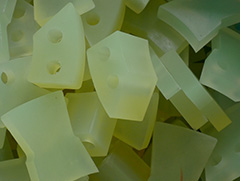How does acidity and alkalinity affect the quality of urethane prepolymers?
 No matter it is the prepolymer synthesis reaction or
various other reactions for the synthesis of CPU, it is related to the acidity
and alkalinity in the reaction system. Acid and basic impurities mainly act as
catalysts. The acidic medium is conducive to the chain extension reaction to
generate carbamate and urea; the alkaline medium promotes the branching and
cross-linking reaction to generate self-polymers of allophanate, biuret and
isocyanate, thereby increasing the viscosity of the prepolymer High and even
gel quickly. Therefore, when preparing the prepolymer, the reaction must be
carried out under acidic conditions.
No matter it is the prepolymer synthesis reaction or
various other reactions for the synthesis of CPU, it is related to the acidity
and alkalinity in the reaction system. Acid and basic impurities mainly act as
catalysts. The acidic medium is conducive to the chain extension reaction to
generate carbamate and urea; the alkaline medium promotes the branching and
cross-linking reaction to generate self-polymers of allophanate, biuret and
isocyanate, thereby increasing the viscosity of the prepolymer High and even
gel quickly. Therefore, when preparing the prepolymer, the reaction must be
carried out under acidic conditions.
The acidity and alkalinity in the system are mainly
derived from the acid value in the polyester, the hydrolysis chlorine in the
isocyanate, and the basic catalyst such as KOH in the PPG. Isocyanates are
produced by the phosgenation method. Hydrolyzed chlorine is the main source of
isocyanate acidity. The acidity of the isocyanate plays the same role as the
acid value of the oligomer polyol, inhibiting the formation of allophanate and
biuret. When using PPG to prepare prepolymers, in order to avoid the appearance
of gel and make the casting mixture have a proper pot life, if necessary, a
small amount of acid or acid chloride can be added to adjust the acidity of the
system. Prepolymers are synthesized in an acidic state. For example, the
temperature of oligomer polyols is controlled at 40-50°C. Generally, the
reaction exothermic temperature rise will not exceed 70°C, while the reaction
exothermic temperature rise can exceed 100°C in an alkaline state. And soon gel
appeared. When the residual KOH concentration exceeds the acidity of TDI, the
maximum exothermic temperature of the prepolymer can rise sharply from 50°C to
130°C. This shows that the prepolymer can be synthesized in a wide range of
acidity, but a small amount of base can catalyze the gel. The effect of TDI
acidity on the formation of prepolymers, it can be seen that the acidity of
isocyanate protects the synthesis reaction of prepolymers.
When the content of hydrolyzed chlorine is 0.01%, the reaction
is normal. When the content of hydrolyzed chlorine is less than 0.005%, the
reaction rate is accelerated, and the prepolymer is easy to gel. When enough
adipoyl chloride was added, the total hydrolyzed chlorine increased from 0.001%
to 0.01%, and the reaction proceeded normally. The hydrolyzed chlorine in
isocyanates is the main source of acidity. Hydrolyzed chlorine is not always
related to the reactivity of the prepolymer, but acidity has always played a
major role. In summary, neither the acidity of the oligomer polyol nor the
acidity of the isocyanate (hydrolyzed chlorine) plays a decisive role in the
formation of prepolymers. The decisive role is the combined effect of the two,
namely prepolymers. The total acidity of the system.










